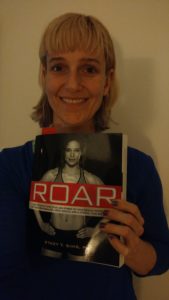In honour of International Women’s Day 2019, this is a blog about the book “Roar: how to match your food and fitness to your female physiology for optimum performance, great health, and a strong, lean, body for life”, by Stacy T. Sims, PhD.

I read the book a while ago, after reading this article on Climbing.com, and have since applied Roar’s wisdom to my training, and general life. One of the most powerful gifts I received was validation of patterns I had observed in my body, but that I had not necessarily linked in any real way to my female hormone cycle. I also now use the Fitrwoman app to track my cycle, and get hints and tips on what kind of nutrition and training I should be considering depending on my hormone level at any given time.
I believe that this is a super important conversation, and one that has not been happening enough. A few years ago I asked two of my fellow female competitors what they did to manage competitions that were in the pre-menstrual stage in their cycles (traditionally the most challenging for me (keep reading below to understand why). Firstly the conversations were super-awkward (but why should they be?! The menstrual cycle is a normal part of being a woman!), and neither of them really had any strategies other than ‘mind over matter’.
So, here are some points from the book that resonated with me personally (paraphrased with my interpretation, not quoted):
- Phase 1 is your period (generally 3-5 days). Oestrogen and progesterone are at their lowest levels.
- In phase 2 (around one week), oestrogen levels rise to a peak just before ovulation, progesterone is low.
- Phase 3 (around one week) sees oestrogen dip around ovulation, and then start to rise again with progesterone.
- In phase 4 (around 5 days before menstruation), hormone levels peak, causing pre-menstrual symptoms, and then start falling.
- High oestrogen = low muscle growth; high progesterone = higher muscle breakdown. This means that it’s harder to make and maintain muscle in the high hormone phase, and it’s more difficult to re-build and repair muscle so the body needs more time for recovery.
- Sleep and the body’s ability to regulate its’ temperature are affected when the hormones start to fall a few days before your period.
- Neural mechanisms (mind-muscle connections) are more important for women’s adaptations to strength training (than men’s).
- A woman’s physiology is most like a man’s during her period and the days that follow – there is a greater capacity for strength gains, more force generation, a higher pain threshold, and better recovery (lucky guys!).
- VO2 max and lactate threshold (anaerobic / endurance performance) stay constant during the pre-menstrual phase, but there is reduced reaction time, reduced neuro-muscular coordination, and reduced manual dexterity during pre-menstruation and menstruation. Blood sugar levels, breathing rates, and thermo-regulation are negatively impacted, which means (slight) decreases in aerobic (cardio, max strength, power) performance can be expected.
- Women need protein with leucine or branched-chain amino acids (BCAAs – leucine, iso-leucine, and valine) – within 30 minutes after exercise.
- 10-15g of protein and 40g (~200 calories) of carbohydrate are needed before a 90min workout, and 40-50g of carbohydrate with protein and fat are needed per hour of workout after that.
- You burn more calories overall during the pre-menstrual phase – women crave carbohydrates because the high oestrogen reduces a woman’s carb-burning ability so more are needed for high intensity exercise.
- Pre-menstrual bloating comes with thicker blood, and that makes exercise feel harder.
- Increased body temperatures and lower sodium (salt) retention with pre-menstruation = more water and salt needed.
- Pre-combat menstrual cramps and diarrhea by taking magnesium, omega 3s, and 80mg aspirin for 5-7 days before your period starts.
- Combat pre-menstrual headaches with spinach (nitric oxide) and water. Be aware that during the high hormone phases the urge to drink – thirst – is dampened.
- We need to drink 415-590mL of water per hour (depending on environmental temperatures).
- At altitude and after acclimation, women burn fewer carbs and more fat for fuel. But don’t reduce your carb intake because this kicks up the breathing response which helps adaptation through increased oxygen intake.
- Prolonged low mood could be an indicator of over-training.
- Research shows that you are better off taking a break when needed than following a rigid schedule, despite your cycle symptoms.
- You should be doing a maximum of three high stress exercise sessions each week, punctuated with easy or rest days in between.
- If your morning heart rate is high (more than 10 beats per minute above your norm), you’re not fully recovered. In this case, your heart rate will not increase to where it needs to be for effective training.
- Cooling down is the first step in active recovery; it’s more beneficial for women who experience a greater decrease in arterial blood pressure after exercise (than men) so nutrients don’t get to the worked cells that need repair.
There are SO many more important points than this, and some that might be relevant to you that aren’t as much to me, so I highly recommend that you read it yourself. And I am always keen to discuss this with anyone who is interested in having the conversation.
One of my biggest takeaways has just been the ability to be more forgiving of, and compassionate towards, my body. Knowing that whatever I’m experiencing is not something to just plough headlong through, or stubbornly endure; it’s my body doing it’s natural thing. And if I work WITH it, rather than DESPITE it, I will feel better, calmer, and more loving of myself. And who can ask for more than that!?


Recent Comments